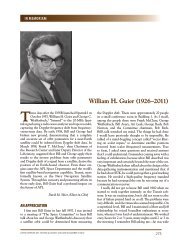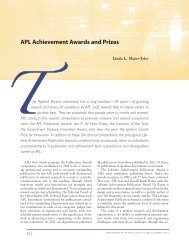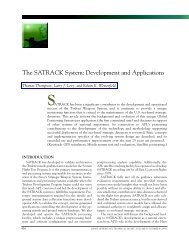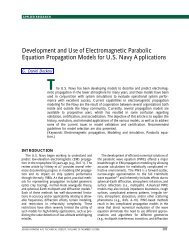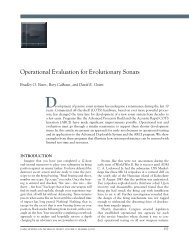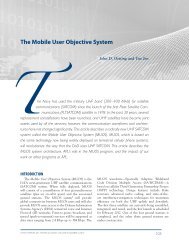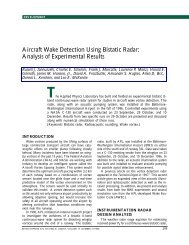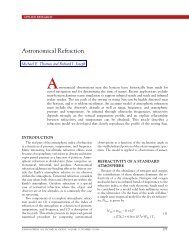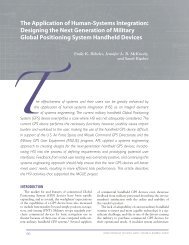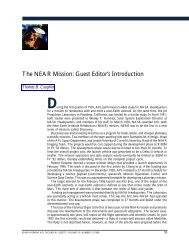A Practical Application of Relativity to Observation and Control of ...
A Practical Application of Relativity to Observation and Control of ...
A Practical Application of Relativity to Observation and Control of ...
You also want an ePaper? Increase the reach of your titles
YUMPU automatically turns print PDFs into web optimized ePapers that Google loves.
S. B. COOPER<br />
for past times <strong>to</strong> provide<br />
a more accurate mapping<br />
between MET <strong>and</strong> TT. That<br />
improved mapping is needed<br />
<strong>to</strong> provide the time accuracy<br />
required for analysis <strong>of</strong><br />
science observations. That<br />
interpolated TDTRATE is<br />
shown in Fig. 3. The interpolated<br />
TDTRATE is based on<br />
both the current time record<br />
in the SCLK kernel <strong>and</strong> on<br />
the next time record, so the<br />
computed TDTRATE <strong>and</strong><br />
derived oscilla<strong>to</strong>r frequency<br />
“lead” the actual performance<br />
<strong>of</strong> the oscilla<strong>to</strong>r. That<br />
is why the change in oscilla<strong>to</strong>r<br />
frequency shown in Fig. 2<br />
appears <strong>to</strong> occur slightly<br />
before the actual change in spacecraft velocity during<br />
the Venus flyby.<br />
A comparison between the interpolated TDTRATE<br />
taken from the Operations SCLK Kernel after the M1<br />
flyby <strong>and</strong> the relativistic prediction <strong>of</strong> TDTRATE given<br />
in Fig. 3 is shown in Fig. 4. The comparison is fairly good<br />
but not perfect <strong>and</strong> suggested that the +31 ppb OCXO<br />
fractional frequency <strong>of</strong>fset <strong>of</strong> the Venus flyby might need<br />
<strong>to</strong> be adjusted.<br />
Analysis <strong>of</strong> TDTRATE following the second flyby <strong>of</strong><br />
Mercury (M2) provided a better fit <strong>of</strong> +28 ppb <strong>to</strong> the<br />
M1 <strong>and</strong> M2 data, after relativistic effects were removed.<br />
However, that same analysis did not provide a good fit<br />
<strong>to</strong> the Venus flyby data, as can be seen in Fig. 5. The<br />
results shown in this figure provided the first prediction<br />
<strong>of</strong> OCXO TDTRATE through the end <strong>of</strong> the primary<br />
orbital phase <strong>of</strong> the mission, following a full Earth year<br />
in orbit around Mercury, <strong>and</strong> was<br />
calculated using spacecraft velocity<br />
relative <strong>to</strong> the Sun <strong>and</strong> the<br />
gravitational effects <strong>of</strong> the Sun,<br />
Earth, Venus, <strong>and</strong> Mercury. The<br />
gravitational effect <strong>of</strong> distant Jupiter<br />
is insignificant at this scale.<br />
This figure was created using an<br />
orbit determination designated<br />
OD153 by our Navigation Team<br />
at KinetX, as noted in the figure;<br />
later orbit determinations were<br />
used for the later figures. Note<br />
that TDTRATE has local maxima<br />
at solar perihelia, indicating that<br />
the OCXO output frequency <strong>and</strong><br />
the clock drift rate have local<br />
minima near perihelia. Similarly,<br />
TDTRATE has local minima at<br />
392<br />
TDTRATE (s/s)<br />
1.00000003000<br />
1.00000002500<br />
1.00000002000<br />
1.00000001500<br />
1.00000001000<br />
1.00000000500<br />
1.00000000000<br />
0.99999999500<br />
0.99999999000<br />
0.99999998500<br />
V2 is second Venus yby<br />
M1 is rst Mercury yby<br />
M2 is second Mercury yby<br />
M3 is third Mercury yby<br />
MOI is Mercury orbit insertion<br />
V2<br />
M1 M2 M3 MOI<br />
Estimated TDTRATE with relativistic effects<br />
Measured TDTRATE<br />
0.99999998000<br />
0 500 1000 1500 2000 2500 3000<br />
Days since launch<br />
Figure 6. Estimated MESSENGER OCXO-B TDTRATE, including the effects <strong>of</strong> relativity, assuming<br />
+26 ppb OCXO fractional frequency <strong>of</strong>fset without relativity, using orbit determination solution<br />
OD179.<br />
Residual fractional frequency<br />
<strong>of</strong>fset (ppb)<br />
35<br />
30<br />
25<br />
20<br />
15<br />
10<br />
5<br />
aphelia, <strong>and</strong> the OCXO frequency <strong>and</strong> clock drift rate<br />
have local maxima at aphelia. In other words, the clock<br />
is running slower at perihelia (larger TDTRATE) <strong>and</strong><br />
faster at aphelia (smaller TDTRATE), due <strong>to</strong> the relativistic<br />
effects <strong>of</strong> velocity <strong>and</strong> gravity.<br />
THE USE OF RELATIVITY TO CONTROL<br />
ONBOARD TIME<br />
It was noted earlier that the onboard G&C subsystem<br />
uses an estimate <strong>of</strong> Earth time. At various times, the<br />
Mission Operations Center uploads new time parameters<br />
<strong>to</strong> the spacecraft <strong>to</strong> allow the G&C subsystem <strong>to</strong><br />
compute an accurate estimate <strong>of</strong> TT from MET. One <strong>of</strong><br />
those parameters is a recently calculated value <strong>of</strong> predicted<br />
TDTRATE. Figure 5 <strong>and</strong> the calculations underlying<br />
the predictions <strong>of</strong> TDTRATE in that figure were<br />
Y = (–0.0043 ppb/day)X + 35.10 ppb<br />
Fractional frequency <strong>of</strong>fset residual (ppb)<br />
<strong>to</strong> t measured TDTRATE<br />
Computed OCXO-B frequency bias,<br />
adjusted for aging (ppb)<br />
0 0 500 1000 1500 2000 2500 3000<br />
Days since launch<br />
Figure 7. First linear fit <strong>to</strong> residual OCXO-B fractional frequency <strong>of</strong>fset.<br />
JOHNS HOPKINS APL TECHNICAL DIGEST, VOLUME 32, NUMBER 1 (2013)





